How To Do a Squat With Perfect Form Every Time
Learn how to do squats perfectly every time. Discover variations, avoid mistakes, and reap the benefits of this essential exercise.
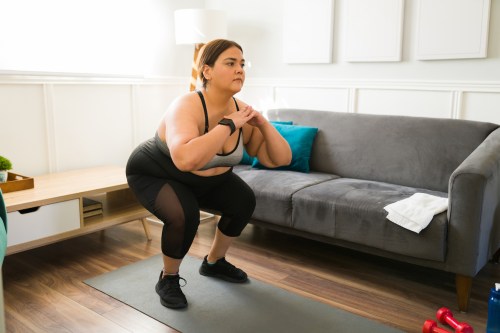
Walk into any gym, and you’re guaranteed to see someone either on a squat rack or squatting with a pair of dumbbells in the free weight area. Squats are one of the most fundamental—and functional—movements, which means they’re not just reserved for leg day.
Experts in This Article
a physical therapist at Bespoke Treatments in NYC
“We mimic squats dozens of times every day, from sitting down onto a chair, to getting into our car, to picking up a bag of groceries off the floor,” says Katherine Kalaj, PT, DPT, a physical therapist at Bespoke Treatments in NYC. “Doing squats in the gym helps us maintain the strength we need to do all of those things much more easily as we age.”
But adding squats to your routine is just as important as doing them with the right form. Here’s exactly how to do squats, plus common mistakes, and tips and tricks to help you modify or level up.
How to do a squat the right way
Before adding weight, you’ll want to nail the bodyweight squat with perfect form. Here’s how to do a basic bodyweight squat:
- 1.Stand with your feet shoulder-width apart, and keep your toes pointing slightly outward.
- 2.Keep your back straight and either hold out your arms straight in front of you, place your hands on your hips, or clasp them together in front of you. (Do whatever feels most comfortable!)
- 3.Then, push your hips back, as if you’re about to sit into a chair. Bend your knees and lower your body, keeping your back straight and making sure your knees are in line with your toes.
- 4.Lower yourself as far as your flexibility allows, keeping your weight on your heels and the balls of your feet rather than on your toes.
- 5.To stand back up, push through your heels, returning to the starting position.
The muscles you work when squatting
You may reserve them for leg day, but squats are one of the best full-body movements you can do. They target your core, which includes your abs and back. Different squat variations, like overhead squats and goblet squats, can also activate your upper-body muscles for a more comprehensive move.
According to the National Academy of Sports Medicine (NASM), squatting muscles worked include:
- Gluteus maximus (largest butt muscle)
- Quadriceps (or quads, for short)
- Hamstrings
- Erector spinae (muscles along your spine and back)
- Inner thigh muscles
- Calves
- Abdominal muscles, including your rectus abdominis (six-pack ab muscles) and your external obliques (side abs)
Squat benefits that’ll convince you to add them to your routine
1. Better core strength
Squats certainly build leg strength and help round out your quads and glutes, but this exercise also improves core strength and balance.
Squats activate many different muscles in your core, including the transversus abdominis, internal and external obliques, and rectus abdominis—and building these muscles can help strengthen your core.
A stronger core can help improve your posture and balance and can make everyday activities easier.
2. A stronger lower body
Squats build out your leg and glute muscles, and the perks go beyond just filling out your jeans. Your legs are used in so many daily activities—obvious ones, like walking and running, and movements you’re probably not thinking about much, like getting out of your car or sitting on the toilet.
A stronger lower body means you’ll be able to perform these movements with more ease and help prevent injury while doing so.
3. Lower risk of injury
Because squats mimic so many everyday movements, doing them at the gym (with proper form) can help you maintain your mobility and the strength to do these movements more easily as you age, according to Kalaj.
“Aside from the benefits we get in terms of aging, squats are a versatile way to strengthen and protect our lower bodies for recreational activities like running, cycling, and other sports,” she says.
Variations to try once you’ve got the hang of standard squats
1. Box squat
“Box squats are a great starting point for people who have a hard time feeling their glutes and ‘sitting back’ into a squat because you can feel more secure that you have something behind you,” Kalaj says.

- 1.Stand a few inches in front of your box with your feet hip-width apart.
- 2.Keep your back straight and either hold out your arms straight in front of you, place your hands on your hips, or clasp them together in front of you. (Do whatever feels most comfortable!)
- 3.Then, push your hips back, as if you’re about to sit into a chair. Bend your knees and lower your body, keeping your back straight and making sure your knees are in line with your toes.
- 4.Squat down to the point where you can tap your glutes onto the box without fully sitting down, keeping your weight on your heels and the balls of your feet rather than on your toes.
- 5.To stand back up, push through your heels, returning to the starting position.
2. Rear-foot elevated split squat
Rear-foot elevated split squats, also known as the Bulgarian split squat, are great because they allow you to strengthen each leg individually, which helps ensure symmetry between each leg, Kalaj says.
Pro tip: For a more quad-focused split squat, keep your torso upright and sink straight down towards the ground. For a more glute-focused split squat, lean your torso forward so you can feel a bigger stretch in the glutes as you lower toward the ground, Kalaj says.
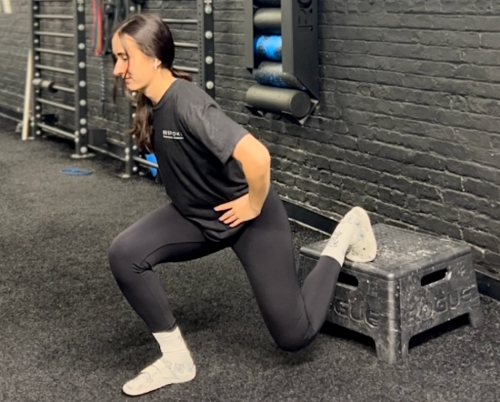
- 1.Grab a bench, chair, or some other sort of elevated platform (ideally between 12 to 16 inches), and place it behind you. If you’re new to the move, you can start with your back foot on the floor, then work your way up to elevating it.
- 2.Stand a full stride’s length in front of the bench and place the top of your foot flat on the surface.
- 3.Tilt your torso forward about 15 degrees, put your hands on your hips, and take a nice deep breath while bracing your core.
- 4.Bend your right (front) knee and hip down, lowering your body as far down as comfortable. Make sure your front knee is in line with your toes, and your back knee is just above the ground.
- 5.Stand back up by pushing through the heel of your front foot to return to the starting position.
- 6.Repeat on the opposite leg.
3. Sumo squat
Sumo squats are a beneficial variation because they more specifically target the adductor muscles of your inner thighs, which are often forgotten.
“The adductors are an important muscle for stabilizing your hips and your pelvis when doing things like running and going up and down stairs,” Kalaj says.
You should feel this variation most in your glutes and adductors (inner thigh muscles) as you lower into the squat, according to Kalaj.
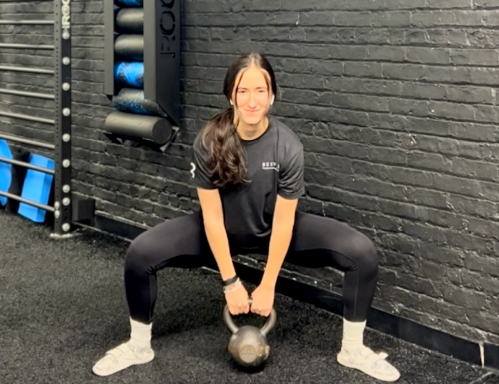
- 1.Stand with your feet wider than hip-width apart, your toes facing slightly outward, holding a kettlebell by the handle with your arms straight down.
- 2.Keeping your back straight, push your hips back, as if you’re about to sit into a chair. Bend your knees and lower your body, keeping your back straight and making sure your knees are in line with your toes.
- 3.Lower yourself as far as your flexibility allows, keeping your weight on your heels and the balls of your feet rather than on your toes.
- 4.To stand back up, push through your heels, returning to the starting position.
4. Goblet squat
Goblet squats are an effective way of targeting your quads to improve the strength and integrity of your knee joint and your tendons surrounding your knee, Kalaj says.
“Holding the weight up in front of you adds an extra challenge for your core stability, as well,” she says.
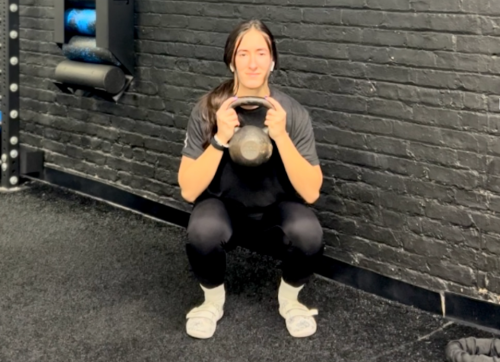
- 1.Hold a kettlebell against your chest with both hands, gripping the handles near the base.
- 2.Keeping your back straight, push your hips back, as if you’re about to sit into a chair. Bend your knees and lower your body, keeping your back straight and making sure your knees are in line with your toes.
- 3.Lower yourself as far as your flexibility allows, keeping your weight on your heels and the balls of your feet rather than on your toes.
- 4.To stand back up, push through your heels, returning to the starting position.
5. Barbell back squat
“Barbell back squats are great for more experienced lifters who are looking to under heavier weights to strengthen their lower body,” Kalaj says. “They’re a great way to strengthen not only your legs, but also your core and lower back.”
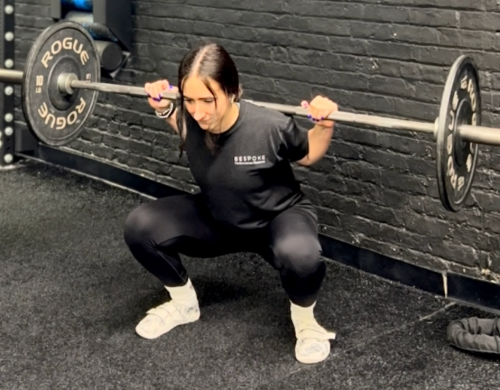
- 1.Set up in a rack with your feet about shoulder-width apart, and the bar resting across your upper back. Grab the bar with an overhand grip (palms facing forward).
- 2.Unrack the bar carefully and set your feet at a comfortable stance with your feet slightly turned out.
- 3.Keeping your back straight, push your hips back, as if you’re about to sit into a chair. Bend your knees and lower your body, keeping your back straight and making sure your knees are in line with your toes.
- 4.Lower yourself as far as your flexibility allows, keeping your weight on your heels and the balls of your feet rather than on your toes.
- 5.To stand back up, push through your heels, returning to the starting position.
How many calories do squats burn—and is it even important?
The calories you burn while squatting depends on the intensity of the squats, how long you do them for, and how much you weigh. Generally, bodyweight squats are low-intensity and will burn around 20 calories for every 5 minutes. The higher the intensity of the squat (like if you were to add weight), the more calories you’ll burn.
It’s also important to keep in mind building muscle burns more calories over time. So, the more muscle mass you have—or gain over time—the more calories you’ll burn during a squatting session.
However, instead of focusing on calories burned, keep in mind all the benefits squats can do for your body, such as increase your lower-body strength, improve your core stability, and round out your glutes.
When you reduce exercise to nothing more than calories burned, it can lead to disordered behaviors. You can be sure you’re making the best choices for your health when you incorporate physical activity you enjoy into your everyday routine.
Common mistakes when squatting
Maintaining proper form when you’re squatting ensures you’re targeting the right muscles—but, more importantly, it helps prevent injury. Next time you’re doing a squat, make sure your form is on point by avoiding these common mistakes.
1. Your torso is too upright
We’re often taught to keep our chest up and our eyes facing forward when we’re squatting, but this actually decreases our ability to engage our core, Kalaj says.
Instead of raising your chest, allow a little bit of forward lean—think “ribs down,” Kalaj says. And pick a point on the ground several feet away from you to focus on.
2. Your knees collapse in
Also called “knock knees,” having the knees collapse as you’re going down in your squat is one of the most common mistakes. This happens when your shins point outward and your thighs rotate inward, and it could lead to knee and ACL injuries, per the NASM.
When you’re squatting, make sure to focus on keeping your knees pushed out and parallel to the floor. Adding a light resistance band around your knees can also help keep your knees aligned.
3. You excessively arch your back
You may have a goal of hitting a very deep squat, but don’t have the hip mobility or core stability to do it without arching your back to compensate.
Arching your back too much can contribute to lower back pain and pressure on your spine that can potentially up your risk of injuries, Kalaj says. Instead, you want to keep your spine neutral.
To help prevent overarching, “warm up for your squats with a hip mobility drill, and make sure to tighten your core before each squat repetition,” Kalaj says.
4. You progress your load too quickly
Once you get your squat form down, you may end up progressing the weight you’re using too quickly. This can cause injuries to your knees, hips, or back, according to Kalaj.
“To prevent this, progress the weights you use gradually and get fully comfortable and strong with one weight before your progress to the next,” she says.
Remember, when it comes to lifting, you’re always better safe than sorry. Put the ego aside and grab a lighter set of weights if you can’t perform a squat—or any exercise, for that matter—with proper form.
FAQ
1. How many squats should you do per day?
The number of squats you do per day depends on your fitness goals. If you’re looking to improve muscle strength, do 2 to 5 sets of 3 to 6 repetitions of heavy squats about twice a week, Kalaj recommends.
If your goal is to build muscle through hypertrophy (or muscle growth), do 3 to 5 sets of 8 to 12 repetitions 2 to 3 times per week.
“No matter what your goal is, it’s important to squat more than one time per week to build your skill through consistency,” Kalaj says.
2. Who shouldn’t do squats?
People with an injury, recent surgery, or those who have specific orders from their doctor not to squat should avoid this exercise. Other than that, there really isn’t anyone who should avoid squats.
“We all do squats so many times each day during our daily activities, so they are a vital part of our life. However, it is important for anyone on their fitness journey to get proper direction from a fitness professional about which squat variation to choose as a proper entry point,” Kalaj says.
3. What happens if you do squats wrong?
As with any exercise, there is always the potential of getting injured if you do too much too soon, or if your form isn’t solid.
Doing squats wrong can lead to lower-body aches and pains, Kalaj says. To help prevent injury, Kalaj recommends working with a physical therapist or a certified strength coach.
“That being said, the risk associated with squats is fairly low, so the fear of injury shouldn’t deter anyone from attempting squats as part of their workout routine,” Kalaj says.
Sign Up for Our Daily Newsletter
Get all the latest in wellness, trends, food, fitness, beauty, and more delivered right to your inbox.
Got it, you've been added to our email list.










